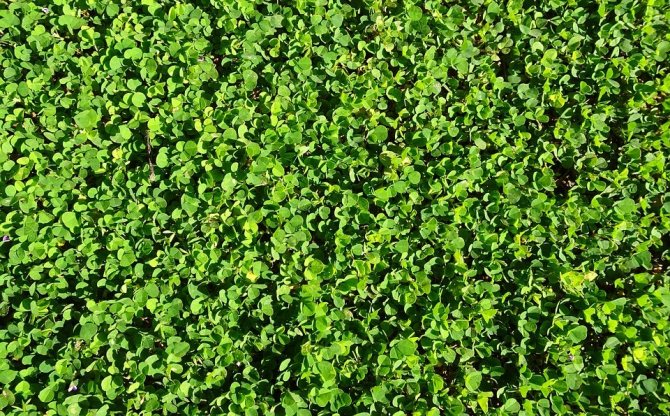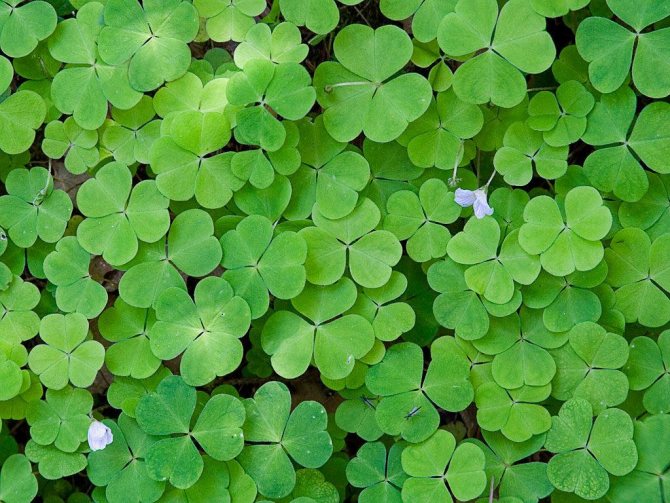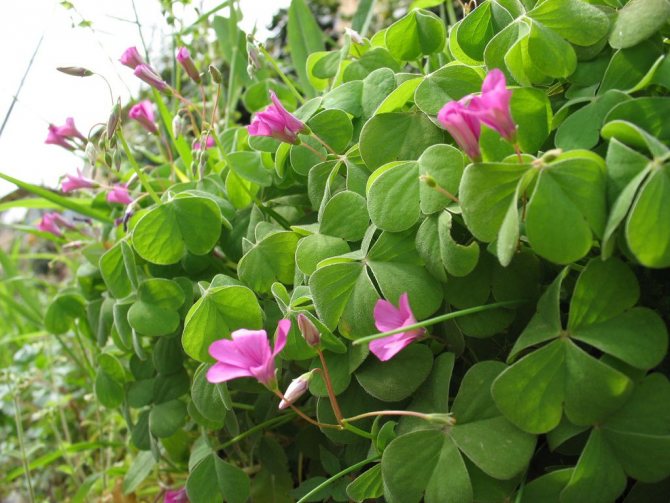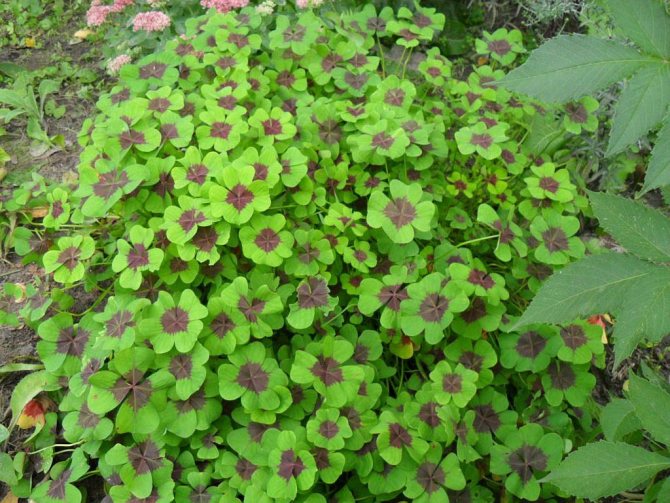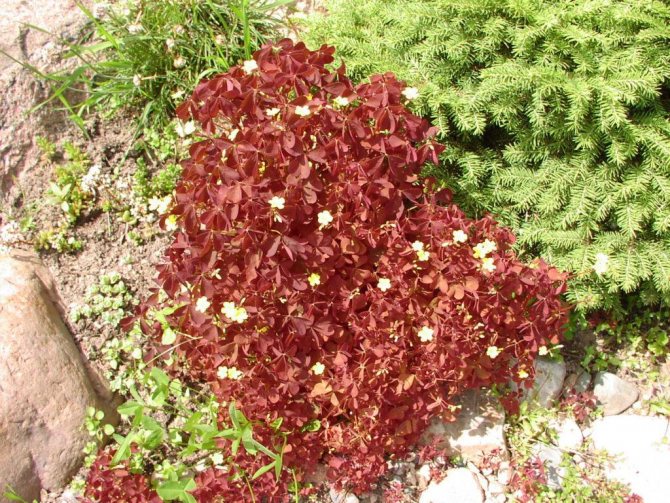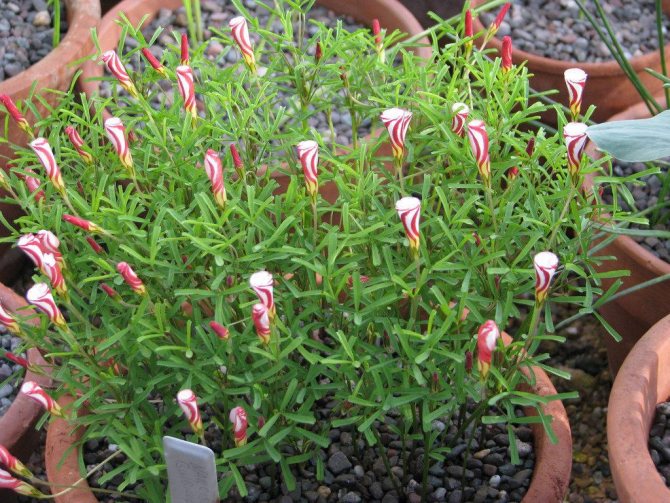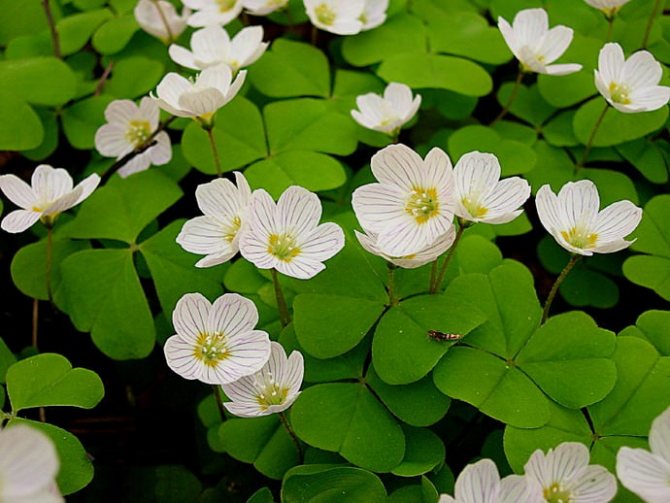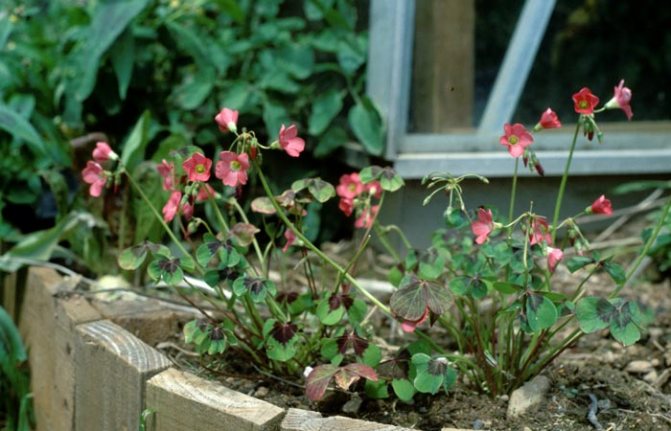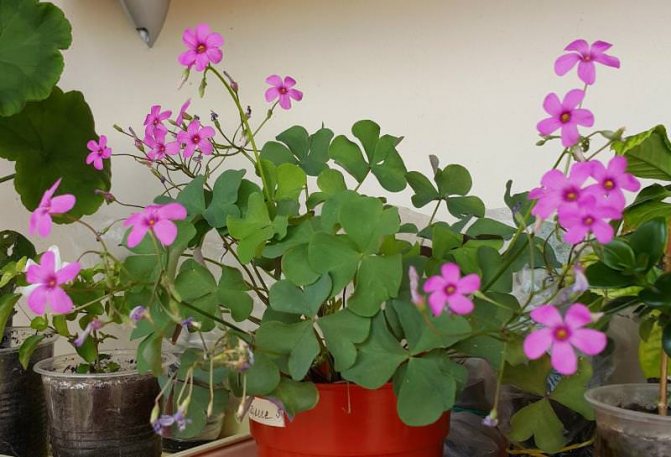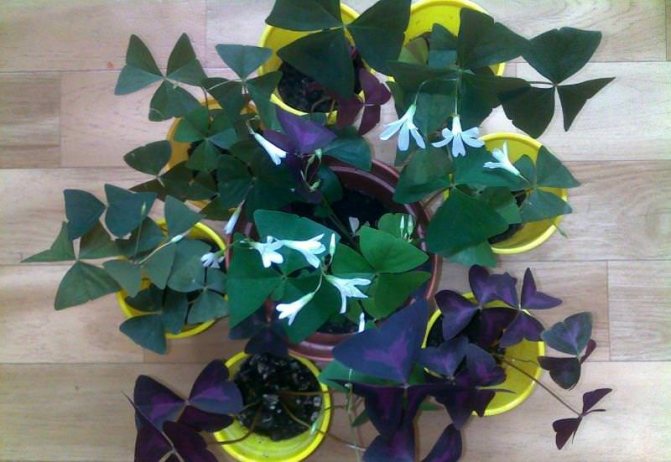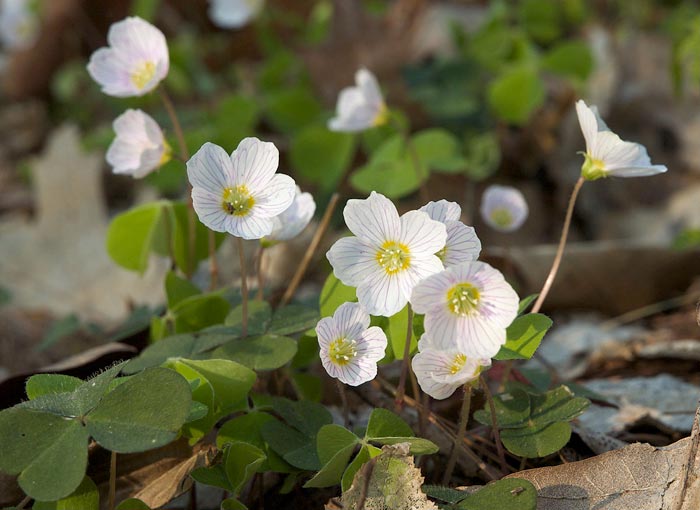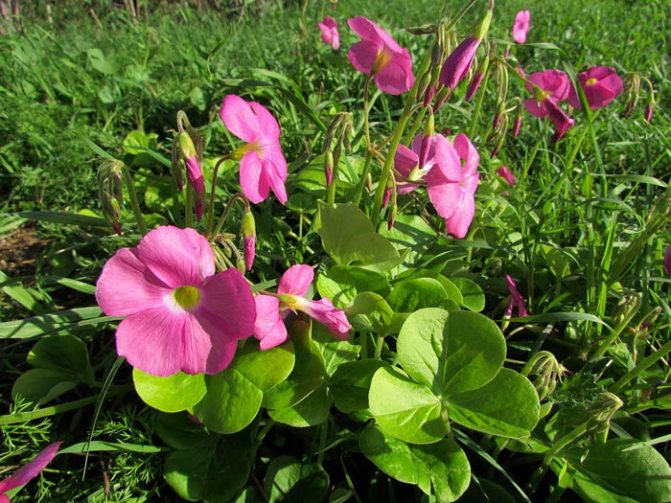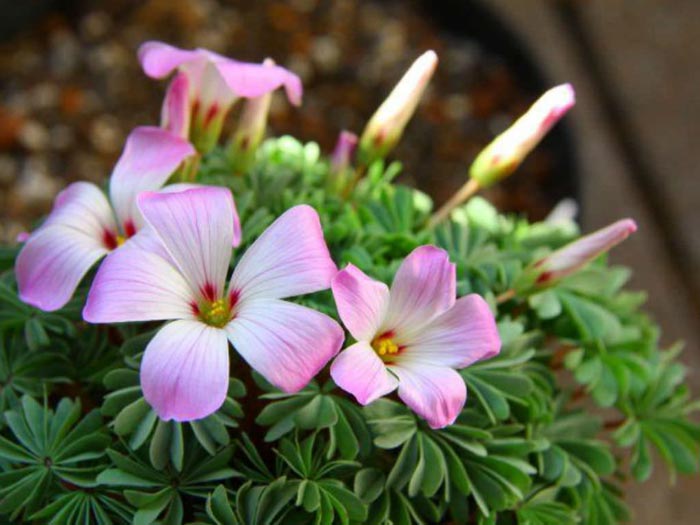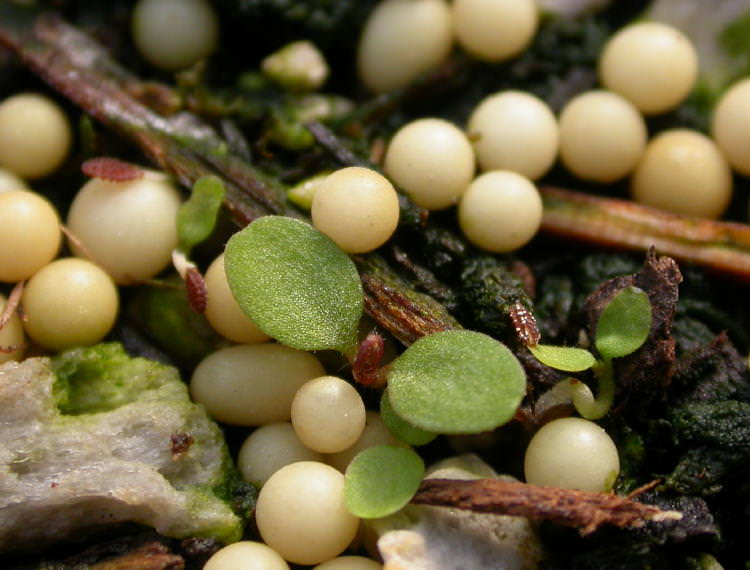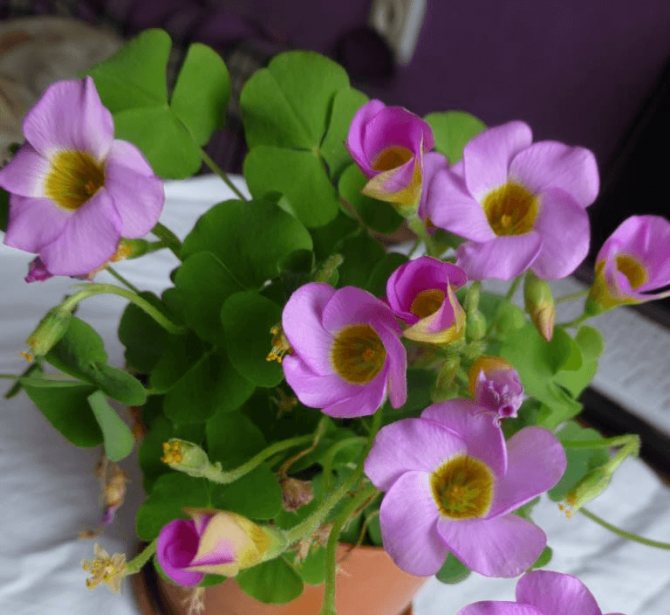General description of the plant
These three-fingered leaves cannot be confused with anything in the world! They look a bit like clover. Only the oxalis trefoil is formed by reverse-heart-shaped, thin leaves.

Small (1-2 cm) white flowers bloom in a white scattering, if you look closely at them, purple veins are noticeable on all five petals.
These flowers are of two types.
Some are pollinated by insects, others (those that are always closed) are self-pollinating.
Hope for nature, but don't do it yourself!
Guided by this rule, oxalis is able to reproduce independently even in a very dark, dense forest.
Inside the "buds", which are actually quite adult, normal flowers, seeds ripen. As they mature, they are thrown out.
Reference! Another interesting feature of the plant. It can be used as a barometer. The fact is that before the rain, the oxalis tightly closes the flower petals.
The leaves are also fancifully folded and descend from top to bottom. The same thing happens every evening, before dark. To bloom again in all its glory with the first rays of the sun!
In general, the plant grows from 5 to 10 cm. The rhizome is creeping. Tuber or bulb. The stem may be missing.
Feels equally good both in the forest and at home.
On our site, we have also prepared articles on growing and caring for at home two of the many types of acid wood: the decorative and unpretentious "Violet Acid" and a short shrub cultivated as a houseplant, "Triangular acid".
Interesting features of the common oxalis
Oxides in the plant world stand somewhat apart. Biologists distinguish them into a special family of oxalis (Oxalidaceae). In total, about 800 species of oxalis are known in the world. The most common in Russia, neighboring countries of Europe and Asia is our "hare cabbage".


It grows in forests - coniferous, deciduous and mixed. In gloomy and shady spruce forests, this is one of the few flowering plants, along with a double-leaved mine and a common seven-leaf. Often, you can see the sorrel in the ravines, along the banks of forest streams.
It is a perennial with a creeping rhizome. Interesting leaves on long petioles grow from the rhizome in spring. These leaves are trifoliate and look a little like clover leaves. But the oxalis trefoil is formed by leaves with a notch at the top - they are called reverse heart-shaped.
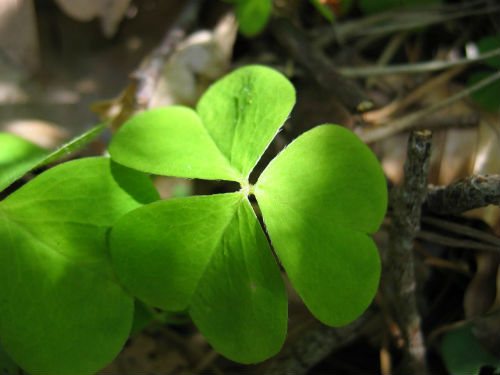

A little later, flowers appear on long peduncles. The flower is large enough - about 2 centimeters in diameter. It has five petals, five sepals. Pinkish-purple veins on the petals. From this, the flowers sometimes seem not white, but pinkish. There is a yellow spot at the base of each petal. Merging, these spots make the center of the flower yellow.
The pistil with five stigmas is surrounded by ten stamens with anthers. Five stamens are long, five are short. Stamens and pistils ripen at the same time. But self-pollination in this case is impossible - the pistil column is one third higher than the stamens. To pollinate these flowers, an insect visit is required. Large, bright flowers, clearly visible in the shady forest, and are needed to attract them.


However, the plant does not quite rely on the rare pollinators here. Uses oxalis ordinary and self-pollination. Only for this does it form special, cleistogamous flowers. They look like unopened green buds only a few millimeters in size. Such flowers appear later, in the middle of summer.
In a closed cleistogamous flower, pollen does not fall out of the anthers. It germinates to form a pollen tube. When the tube reaches the ovary, fertilization occurs. There is a back-up pollination mechanism in case cross-pollination has not occurred.
However, two types of flowers are an interesting feature not only of the common sour. After all, the common loosestrife growing in thickets of shrubs also forms open flowers, chasmogamous - for insects, and inconspicuous, cleistogamous - for self-pollination.
The violet is amazing with similar features of reproduction with the formation of cleistogamous flowers.
Of interest is the ability of the common sour cherry to close flowers and fold leaves. This happens in bad weather. Flowers droop and close, the leaves fold and also go down. The plant protects its delicate parts from rain. With the establishment of sunny weather, everything is revealed again.
But even in good weather, every evening oxalis ordinary folds the leaves and closes the flowers. And every morning it opens up towards the sun's rays. Such is the plant - "sun worshiper"!
If you knock on the leaves or the flower of the sorrel with your finger, it will also close. This does not happen as quickly as in "mimosa" - yellow acacia. But the acid works in a similar situation in a similar way.
The methods used by the plant to spread the seeds are also interesting. When the seed boxes ripen, they open, as they say, "with a bang." And the seeds are thrown to the side with force, flying off at a distance of at least a meter. If we take into account the small growth of the sorrel - no higher than 10 cm - this is very far.
Ants participate in the further spread of sour seeds. She, therefore, is also a plant - myrmecohor. Like the liverwort, for example.
But this is still not enough! Seeds are able to move in space and independently!
Naturalists carried out curious experiments with the seeds of acid sour. If you put such a seed on a piece of paper for conspicuousness and breathe on it, the seed will jump to the side!
The air we exhale is always more humid. Apparently, at high humidity, tension arises in the seed shell, and it works like a spring. But in nature, air humidity changes constantly. A seed thrown out by the plant and not yet sprouted is lying on the ground. But now the air becomes humid. The result is a jump! And further away from the mother plant.
Acid "hare cabbage" was named for the sour taste of its leaves, due to the increased content of oxalic and ascorbic acids. It also contains malic and succinic acids. However, the chemical composition of the acid sorrel is still insufficiently studied.
Photo
The photo shows the plant "Ordinary Oxalis (Lesnaya)":
Signs and superstitions
Kislitsa is a very welcome guest in the house. She promises peace in the family, prosperity, protection from quarrels and omissions, frequent meetings with friends. The house can easily turn into a full bowl, a place of joyful meetings and gatherings with friends and relatives. It is believed that a flower will help single people solve personal problems and find their soul mate, as well as get rid of despondency and depression. In some countries oxalis serves as a wonderful gift for Christmas or New Year, as a source of joy and financial well-being.
Home care
Post-purchase actions
Care after purchase is not difficult, since oxalis is also unpretentious in the forest. The main thing is to keep away from direct sunlight, water on time.
Pruning
It is enough to pick a few leaves for infusion or salad. Oxalis is a fairly independent plant that does not require any additional care.
Watering
In hot weather, it requires watering. Especially if it grows in the sun. Do not forget that oxalis prefers moisture in the forest! If we are talking about room acid, then in winter the amount of water should be reduced.
Landing
At home


In a pot, your oxalis will also feel great.
This is just the plant that will suit all hostesses.
From personal experience: Vereitinova Alesya is a journalist. Many times I forgot to water the acid. Not to mention fertilizers, which I don’t understand at all, so I don’t use them. But she is not discouraged! On the contrary, in a constantly dark apartment he feels great. Even better than my other plants.
You can plant sour cherry with seeds. This is done in early April in a greenhouse or in pots at home. Although some gardeners sow directly into open ground. The best time for this is the end of April.
In a garden setting
Kislitsa fits perfectly into the alpine slide. Feels great on stony ground! Just select a shady area for her. Grows well under trees. It is the soil with high acidity. To please her, it is enough to add peat or compost, this will slightly oxidize the soil.
Important! Oxalis ordinary is quite thermophilic, so it is better to insulate it for the winter.
Transfer
Some gardeners dig up sour cherry tubers in the fall to preserve the plant until spring. Immediately after - it is necessary to wash them, separate the "children" and dry well. The plant is transplanted in the spring, when the air temperature at night will keep at around 10 degrees. The distance between the tubers should be about 10 cm, the planting depth should be about 4 cm.
Cultivation and reproduction
Oxide is easy and simple to grow. Planting - Watering - Harvesting! Just choose where it will grow with you. Of course, she will be much more pleasant at home in a pot, but she will not disappear on the street either.
"Kislitsa" reproduces in 3 ways:
- Seeds;
- Tubers;
- Bulbs.
Planting oxalis in open ground
Place for planting acid
Kislitsa likes good diffused lighting, it grows well in partial shade. For growing acid wood in room culture, oriental windows are ideal. On the south side, you need to shade to avoid sunburn.
Soil
Neutral or slightly acidic, fertile and drained are suitable for her. When planting, it is good to add peat, compost to the soil (one bucket per square meter), to improve drainage on heavy soils - a bucket of sand.
For planting in containers, a soil mixture is prepared from turf, leaf, humus soil and sand (1 part each) with the addition of 2 parts of peat. You can purchase a ready-made mixture for ornamental deciduous plants. At the bottom of the containers, drainage from expanded clay, broken brick must be laid. 2-3 handfuls of sand are poured on top of the drainage layer, and then nutrient soil.


Application
How to stock up and use. Sour leaves can be used fresh. There are salad recipes with her direct participation. It is also used for making delicious cabbage soup and stews from it, as well as from sorrel.
Reference! Since the times of Ancient Russia, recipes for incredible soft drinks have come down to us just on the basis of ordinary acid sour.
It can also be dried for the winter. Only it is better to do it in the shade, in a ventilated room. Since the leaves are very delicate and wither easily.
Some peoples still pickle or candied sour leaves. Since, even in this form, it stores in itself a huge storehouse of vitamins and minerals we need. Especially rich in ascorbic acid!
Oxalis in landscape design
Due to the variety of shapes and colors, decorative foliage, the possibilities of using oxalis are enormous.These are a variety of flowerpots and pots, planting acid trees in the first tier of mixborders, on alpine slides and rockeries, in the form of carpet beds and borders, for planting in groups on lawns and flower beds. Sour cherry is planted to fill the empty space after early spring ephemeroids, under trees and shrubs.
Among the oxalis there is an aggressor plant - carob oxalis. When planting it in the garden, it grows with lightning speed, scattering seeds. It will be difficult to get rid of it.
Benefit and harm


The healing and taste properties of acid sour were noted long before us.
Scientists still have not been able to comprehend the full power of this plant.
And while official medicine refuses to take acid as medicine.
For many centuries, the people have been treating stomach and intestinal ailments, liver and kidney diseases, female recurrent pains, purulent wounds and even tumors with it.
What are they not doing with her ?! Sour acid is infused in boiled water in a raw and dried form, rubbed into the skin, eaten on certain days ...
But do not forget that biologists still classify acidic sour as a weakly poisonous plant! So, excessive use of it is not so safe. In veterinary medicine, there have been cases of death of small ruminants from overeating acid.
Attention! For a person, excessive eating of this plant can result in acute liver and kidney diseases, urolithiasis and poor blood clotting.
As our grandmothers said - everything that does not know the measure is harmful! But, nevertheless, no one refused the acid.
Application and medicinal properties of acid


The herb infusion is used to regulate digestion, relieve heartburn, liver disease, jaundice, kidney inflammation (1 teaspoon of the herb is poured with 2 cups of boiling water, insisted for 2 hours and drunk 3-4 times a day). Especially useful are alcohol and water infusions for metabolic disorders.
Acid is credited with diuretic and choleretic properties, as well as a facilitating effect in case of menstrual diseases (half a teaspoon of dry grass is poured with a glass of boiling water, insisted for 2 hours, filtered and taken 3-4 times a day by a tablespoon).
Sour acid is also used externally. Stronger infusions are prepared for washing pustular wounds, ulcers, tumors; you can also use fresh leaves by applying them to diseased parts of the body.
Reproduction and planting
Oxalis multiplies easily. In order for the plant to develop and bloom as quickly as possible, you need to follow some rules and take proper care of the plantings.
There are three main breeding methods:
- seeds;
- bulbs and tubers;
- cuttings.


Seeds
Seed planting can be carried out directly into the ground, but it is better to take care of this in early spring (late March - early April). In this case, the chances of germination of planting material are noticeably increased, and the plant will be able to show itself in all its glory much faster. This will require a container with fertile soil. Seeds are poured onto it. At the same time, you do not need to cover them with a layer of earth - they will germinate without it.
The only thing that is needed is polyethylene or glass, thanks to which it is necessary to create the effect of a greenhouse. The soil in the container should be moistened daily, but in no case with a stream of water, but with a hand spray. It is recommended to use settled water at room temperature. If the right conditions were created and the necessary care was provided for the plantings, then the first shoots may appear in a week, or maybe they will need a month. They are suitable for diffused light and a cool temperature - about + 17 ° C. When the sprouts are strong, the seedlings can be planted in pots, flowerpots, or open ground.
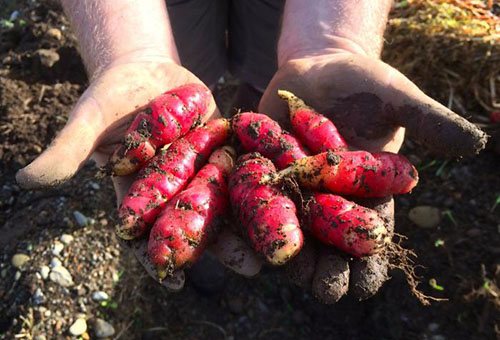

Vegetative propagation
Vegetative reproduction is more popular. Oxalis has a root structure consisting of a main shaft and bulbs (other species produce tubers).It is them that need to be separated, and then used as planting material.
- Planting bulbs (tubers) is carried out in pre-prepared pots of 2-3 pieces or directly into the soil at a distance of 10 cm from each other. It is better to pre-treat them with a manganese solution in order to kill possible pests and prevent the spread of the fungus.
- The bulbs or tubers are sprinkled with a thin layer of earth and watered and then maintained regularly.
- After a month and a half, you can see lush bushes already preparing to bloom.
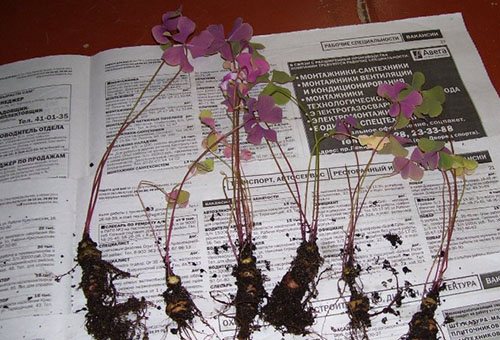

Cuttings
Oxalis also propagates by cuttings. In some cases, even one leaf can be rooted. But it is better for this purpose to cut off the leaf with part of the stem and either put it in water (it must be changed regularly), or plant the soil. For this, a mixture of sod and leafy soil, garden soil and humus is best suited, which are recommended to be taken to each in equal parts (1: 1: 1: 1). After rooting, the future flower can be planted in a permanent place.
Success depends not only on whether the breeding and planting procedure was carried out correctly. Regular grooming is essential. Although frost-resistant species of sour cherry do not impose special requirements on the conditions, truly beautiful specimens can be grown only by observing certain rules.
Oxalis feels great both in shaded and sunny areas. But the color of its leaves may depend on the degree of illumination. Oxalis loves neutral and slightly acidic fertile soils. This plant loves moisture, so a semi-shaded place is perfect for it - this way the earthen ball will dry much more slowly.
Like any plant, oxalis gratefully responds to caring for it carefully throughout the year.
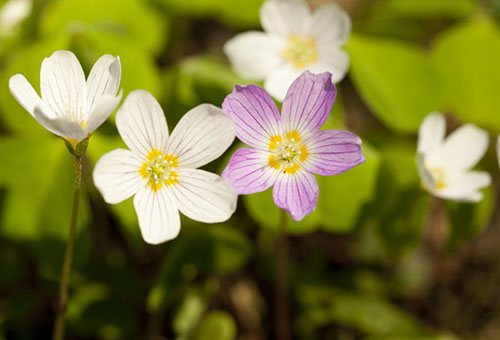

Popular varieties
The genus Oxalis includes almost eight hundred species of plants from the oxalis family, which naturally grow in South Africa, South and Central America and Central Europe.
| Name | Plant | Flowers |
| Poor or pressed oxalis (OxalisinopsEcklonetZeyh) | Small bulbs. Leaves of the trifoliate type, located on rather thin petioles | Large, dark pink with a yellowish center |
| Bowie sour (Oxalis bowiei Herb.) | Light green color, leathery leaves, located on relatively tall shoots | Dark pink, medium size |
| Volcanic oxalis (Oxalis vulcanicola Klee) | Shoots are covered with green, slightly brownish leaves, formed into a lush curtain | A large number of small, yellow colored flowers are formed |
| Giant Oxalis (Oxalis gigantea Barneoud) | Straight shoots with drooping branches and oval three-lobed leaves | Presented by attractive yellow petals |
| Nine-leaved oxalis (Oxalis enneaphylla Cav.) | Plant with petiolate long-lobed, silvery-grayish-green foliage | Consist of whitish or pinkish petals |
| Depp's oxalis (Oxalis deppei Lodd) | Provides nutritious edible tubers and reverse heart-shaped foliage | Umbellate, crimson or red, with a yellowish base |
| Glandular oxalis (Oxalis adenophylla) | Foliage palmate complex, corrugated type, light green color | Relatively large, pinkish |
| Variety "Versicolor" or Versicolor | With bright green oblong leaves | When half-open, they look like red and white candies. |
| Variety "Iron Cross" | The leaves are green, with the presence of purple cruciform spots | Pinkish red, decorative, bell-shaped, on thin, relatively long peduncles |
| Variety "Golden Cape" or golden cape | Graceful, pale green medium-sized leaves | The flower, when fully opened, is red on the outside and white on the inside |
Less popular varieties in indoor floriculture are oxalis anomala (Oxalis anomala), oxalis articulata, oxalis succulenta with bronze-green leaves and var. Minutifolia.
The main characteristics of the garden sour sorrel
The plant was once called sour due to the sour taste of the leaves, which contain a high percentage of ascorbic and oxalic acid. Most representatives of the culture are represented by miniature squat plants about 15 - 35 cm in height. In the garden, they are usually grown as a groundcover. The taller and taller bushes of other types of oxalis fit perfectly into the ensembles of the alpine hills.
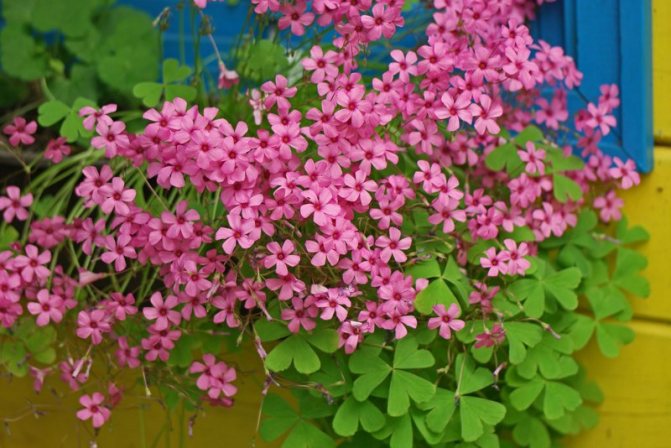

All varieties of garden sorrel are united by characteristic features: trifoliate long-petiolate leaves and small five-petal flowers. The foliage of the garden sorrel is purple, deep burgundy, bright green or marked with dark spots. The color of the flowers, depending on the species, varies from white and yellow to pale and rich pink.
Fertilization
The first two years after planting an acidic bush, top dressing is not required, provided that the planting technology is followed and the required amount of top dressing is added to the planting hole. At the beginning of the spring period, as soon as the shoots begin to grow, twenty grams of urea or thirty grams of ammonium nitrate are introduced under each bush.
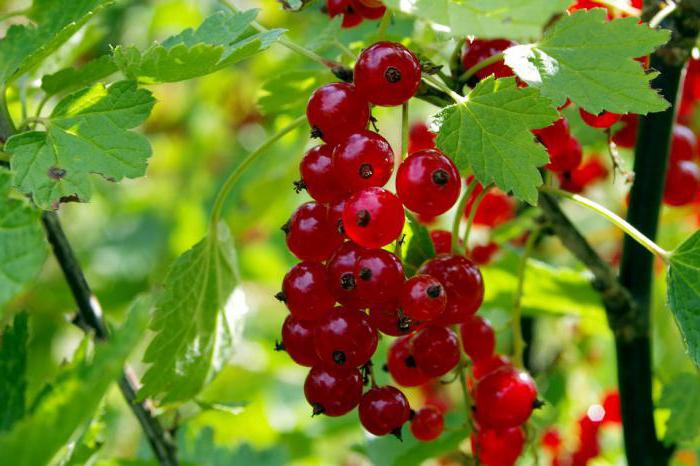

After flowering, it is advisable to feed it with organic matter: an aqueous solution based on bird droppings (1:20) or mullein (1:10). A bucket of such a solution is introduced under the currant bush. In addition, red currants can be fed with complex mineral fertilizers at the rate of twenty grams per square meter. In late autumn, she needs mineral and organic fertilizers.
Kislitsa recipes
We offer you to prepare vitamin dishes and drinks from acid sour.
- There are many benefits in a refreshing sour drink: chopped leaves (200 g) + cold boiled water (1 L). It is taken with honey after a 2-hour infusion.
- You will be pleasantly surprised by the incomparable taste of spring sour salad: chopped leaves (400 g) + finely chopped cucumber (20 g). The mixture is complemented with chopped onion feathers (20 g), sour cream (2 tablespoons). It remains to salt. If desired, you can include parsley in the dish; instead of sour cream, use mayonnaise or vegetable oil. Dill will be useful in the dish.
- An original appetizer: chopped sour leaves (500 g) + chopped dill and parsley (50 g each), black currant leaves (50 g). We refine all this with chopped horseradish root and garlic (you can do with one head), black pepper (peas). Divide into banks. Add 1 tablespoon of brine and cold water (1 L). Can be included in cabbage soup and salads.
- Delicious sandwiches are made from sour paste. 0.1 kilo of grass is passed through a meat grinder. Add butter (200 g), salt, pepper, mustard.
However, oxalis found even wider application in folk medicine.
